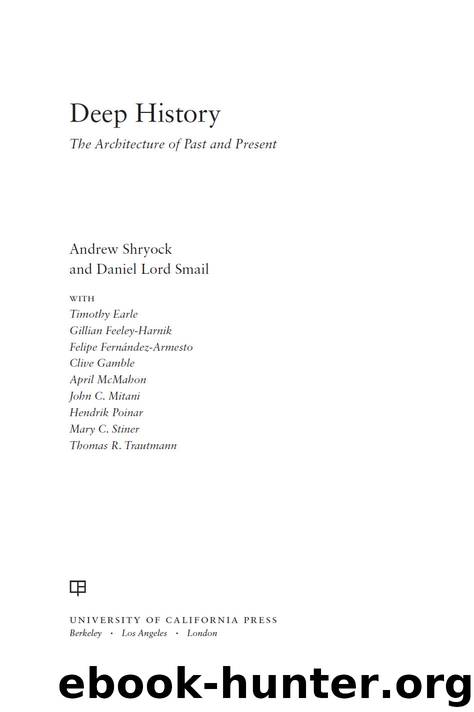Deep History by Shryock Andrew & Daniel Lord Smail

Author:Shryock, Andrew & Daniel Lord Smail
Language: eng
Format: epub
Publisher: University of California Press
Published: 2011-11-16T16:00:00+00:00
KIN RECOGNITION
Humans do not find it particularly difficult to distinguish kin from nonkin. Family ties validated and reinforced through language usually make clear who is related to whom. But do primates recognize their kin? If so, what mechanisms do they employ to discriminate kin from nonkin? What, if anything, do primates know about the kin relations of others? Experiments with captive monkeys show that they are unable to discriminate unfamiliar kin from unfamiliar non-kin.16 Surprisingly, females appear to be incapable of recognizing their own offspring: they readily serve as foster mothers to unfamiliar infants, of the same and different species.17 Yet primates discriminate relatives from nonrelatives during their normal, day-to-day affairs, providing prima facie evidence for kin recognition. For example, female monkeys can discern the calls of their own infants from those produced by unrelated individuals.18 In many species, individuals associate with and maintain proximity to kin more frequently than to non-kin.19 Relatives groom each other more than do unrelated individuals. Kin selectively share food and aid each other in fights.
Such recognition occurs largely through the maternal line. Female primates form enduring relationships with their offspring, making maternal relationships easy to determine for the animals themselves as well as for human observers. In contrast, mating associations between male and female primates are typically ephemeral, with females frequently mating multiple males. As a consequence, it is unclear whether primates can distinguish their paternal relatives. Recent studies nevertheless suggest that paternal kin relationships affect the behavior of primates in some unanticipated ways. Male baboons and capuchin monkeys avoid mating their paternal half sisters and daughters, respectively.20 Female macaques and baboons affiliate preferentially with their paternal half sisters, and male baboons selectively aid their own infants when they are threatened by others.21
These findings remain controversial, as the mechanisms primates employ to identify their paternal kin are unclear.22 Other studies indicate that individuals in other primate species fail to recognize their paternal kin. For example, female pig-tailed macaques and female baboons do not recognize their paternal half sisters.23 Male chimpanzees and female capuchin monkeys affiliate with their paternal half siblings and unrelated individuals equally often.24 Taken together, these conflicting results indicate that, in the absence of a convincing mechanism of identifying kin, questions about paternal kin recognition by primates will remain open.
In contrast, a relatively simple mechanism exists to explain how primates recognize their maternal kin. Here it is generally assumed that primates learn to recognize their maternal relatives through association and experience obtained during development.25 In primates, prolonged periods of infant development, extended periods of maternal care, and long life spans create social groups whose members consist of overlapping generations of related individuals. Kin thus have ample opportunity to become intimately familiar with each other as they interact daily and repeatedly over long periods (figure 15).
Download
This site does not store any files on its server. We only index and link to content provided by other sites. Please contact the content providers to delete copyright contents if any and email us, we'll remove relevant links or contents immediately.
The Leavers by Lisa Ko(6473)
Born to Run: by Christopher McDougall(6260)
iGen by Jean M. Twenge(4702)
Sapiens by Yuval Noah Harari(4537)
The Kite Runner by Khaled Hosseini(4435)
Spare by Prince Harry The Duke of Sussex(4195)
Bullshit Jobs by David Graeber(3179)
Livewired by David Eagleman(3121)
Goodbye Paradise(2962)
Never by Ken Follett(2880)
A Dictionary of Sociology by Unknown(2518)
Harry Potter 4 - Harry Potter and The Goblet of Fire by J.K.Rowling(2416)
The Club by A.L. Brooks(2360)
People of the Earth: An Introduction to World Prehistory by Dr. Brian Fagan & Nadia Durrani(2346)
The Social Psychology of Inequality by Unknown(2310)
Machine Learning at Scale with H2O by Gregory Keys | David Whiting(2290)
Harry Potter and the Order of the Phoenix (5) by J.K. Rowling(2227)
0041152001443424520 .pdf by Unknown(2220)
Don't Sleep, There Are Snakes by Daniel L. Everett(2216)
